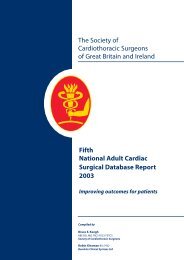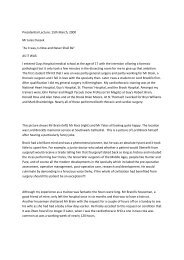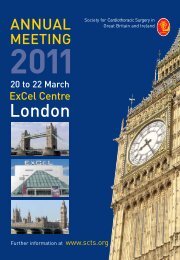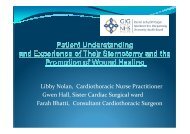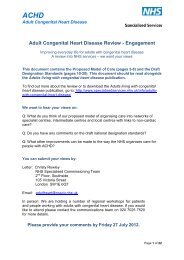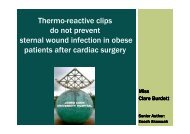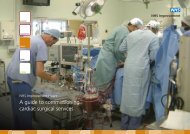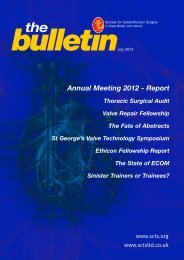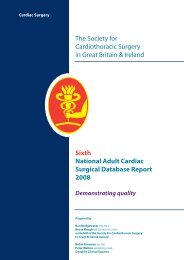Download - Society for Cardiothoracic Surgery
Download - Society for Cardiothoracic Surgery
Download - Society for Cardiothoracic Surgery
You also want an ePaper? Increase the reach of your titles
YUMPU automatically turns print PDFs into web optimized ePapers that Google loves.
July 2010 23<br />
Professor Chris Imray PhD FRCS FRCP<br />
UHCW NHS Trust, Coventry and Warwick Medical School<br />
Lhotse Face<br />
acclimatise<br />
elsewhere on<br />
safer ground, so<br />
that we could<br />
move through<br />
the icefall more<br />
quickly.<br />
‘Coffee, tea or French onion soup?’ was the<br />
question Sundeep asked me, as we settled<br />
into Camp 3, perched halfway up the<br />
Lhotse Face at about 7,100m. The Face is a<br />
1,500m (4,500ft) ice and snow slope<br />
angled at between 40-50 degrees. Our<br />
campsite (!) was a narrow strip of<br />
horizontal space and had been carved out<br />
of the steep ice and snow slope by our<br />
sherpas. On the one side blocks have been<br />
cut out of the slope, and on the other the<br />
blocks have been used to build up a ramp<br />
to give a six foot wide horizontal terrace to<br />
place our tent.<br />
South Col<br />
On first arrival, the South Col had a<br />
deceptively benign appearance. In the sun<br />
and without any wind, it was warm enough<br />
<strong>for</strong> T shirts. It was only later when the sun<br />
set and the wind picked up that we began<br />
to appreciate the true harshness of the<br />
place. Temperatures plummeted to as low<br />
as -35C, and with oxygen levels 1/3 of<br />
those found at sea level, we began to<br />
appreciate what was meant by the term the<br />
‘death zone’. At this altitude, the body is<br />
deteriorating all the time, and life is<br />
unsustainable <strong>for</strong> any length of time.<br />
Without oxygen even the simplest of tasks<br />
such as brushing ones teeth took on<br />
gargantuan proportions, requiring a rest to<br />
complete the task.<br />
Most teams arrive at the South Col in the<br />
early afternoon, they then spend a few<br />
hours rehydrating and<br />
sleeping be<strong>for</strong>e setting off<br />
on their summit attempt<br />
somewhere between<br />
9.00pm and midnight. Our<br />
plan was different; we had<br />
the most ambitious range<br />
of scientific experiments<br />
ever undertaken at this<br />
altitude to undertake in the<br />
world’s highest ‘laboratory’<br />
on the South Col (8000m).<br />
We spent a day setting up<br />
equipment, followed by two days of<br />
experiments ranging from cerebral<br />
perfusion studies to maximal bicycle<br />
exercise tests. At rest and off supplemental<br />
oxygen our blood oxygen saturations were<br />
between 48-56%, (normally 99%) and with<br />
exercise these levels dropped further,<br />
understandably our bodies were<br />
deteriorating continuously. In total, we<br />
spent 5 nights on the South Col- we believe<br />
this is the longest anyone has ever spent<br />
there.<br />
The results so far<br />
One of the questions asked is ‘Have we<br />
learnt any lessons <strong>for</strong> critically ill patients?’<br />
Although much data is still in the process<br />
of being analyzed there are some<br />
interesting and potentially important<br />
messages emerging from the preliminary<br />
data.1,2,3 Perhaps the most notable being<br />
expedition leader Mike Grocott’s paper in<br />
the NEJM on arterial blood gases and<br />
oxygen content in climbers on Mount<br />
Everest. It demonstrated that individuals<br />
appear to be able to function reasonable<br />
normally (!) with exceptionally low arterial<br />
blood oxygen levels. Four of us underwent<br />
femoral arterial stabs at 8,400m, and a<br />
sherpa ‘ran’ these down to Camp 2 at<br />
6,400m <strong>for</strong> analysis. This descent took us<br />
two days, but Pasang managed it in two<br />
hours -with time <strong>for</strong> tea at the South Col!<br />
‘‘In four samples taken at 8400 m (27,559<br />
ft)-at which altitude the barometric<br />
pressure was 272 mm Hg (36.3 kPa)-the<br />
mean PaO2 in subjects breathing ambient<br />
air was 24.6 mm Hg (3.28 kPa), with a<br />
range of 19.1 to 29.5 mm Hg (2.55 to 3.93<br />
kPa). The mean PaCO2 was 13.3 mm Hg<br />
(1.77 kPa), with a range of 10.3 to 15.7 mm<br />
Hg (1.37 to 2.09 kPa).’’1<br />
Conclusions<br />
The mountain was climbed, everyone<br />
returned home safely, and<br />
great friendships were <strong>for</strong>ged.<br />
Judged by conventional<br />
criteria Mike Grocott has lead<br />
one of the most successful<br />
Everest expeditions ever. On<br />
the research side, tantalizing<br />
initial insights into the<br />
pathophysiology of hypoxic<br />
‘healthy’ individuals and the<br />
critically ill are beginning to<br />
emerge. However, perhaps<br />
the most remarkable aspect<br />
of the expedition were the incredible<br />
sherpas. With enormous good grace and<br />
humour they per<strong>for</strong>med amazing physical<br />
feats often in a very dangerous<br />
environment under extreme hypoxia.<br />
Surely their genetic and physiological<br />
adaptation offers the most obvious line of<br />
research in trying to understand to the<br />
response of humans to extreme hypoxia?<br />
Acknowledgements<br />
The expedition was supported by Mr. John<br />
Caudwell, BOC Medical (now part of Linde Gas<br />
Therapeutics), Eli Lilly, the London Clinic, Smiths<br />
Medical, Deltex Medical, and the Rolex Foundation,<br />
the Association of Anaesthetists of Great Britain<br />
and Ireland, the United Kingdom Intensive Care<br />
Foundation, and the Sir Halley Stewart Trust.<br />
Caudwell Xtreme Everest is a research project<br />
coordinated by the Centre <strong>for</strong> Altitude, Space, and<br />
Extreme Environment Medicine, University College<br />
London. Membership, roles, and responsibilities of<br />
the Caudwell Xtreme Everest Research Group can<br />
be found at: www.caudwell-xtremeeverest.co.uk/team.<br />
1. Grocott MP, Martin DS, Levett DZ, McMorrow R,<br />
Windsor J, Montgomery HE; Caudwell Xtreme<br />
Everest Research Group. (Collaborator and<br />
Subject 3) Arterial blood gases and oxygen<br />
content in climbers on Mount Everest. New<br />
England Journal of Medicine. 2009 Jan<br />
8;360(2):140-9.<br />
2. Firth PG, Zheng H, Windsor JS, Sutherland AI,<br />
Imray CH, Moore GW, Semple JL, Roach RC,<br />
Salisbury RA. Mortality on Mount Everest, 1921-<br />
2006: descriptive study. British Medical<br />
Journal. 2008 Dec 11; 337: a2654. doi:<br />
10.1136/bmj.a2654.<br />
3. Wilson MH, Newman S, Imray CH. The cerebral<br />
effects of ascent to high altitudes. Lancet<br />
Neurology. 2009 Feb; 8(2):175-91.



